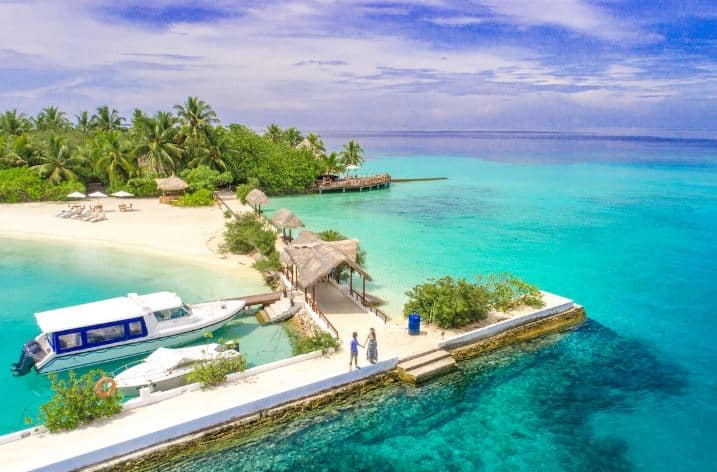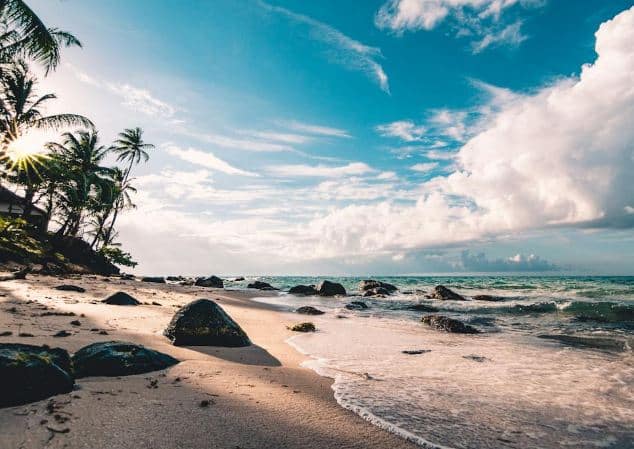Andaman and Nicobar Islands: A Tapestry of History, Geography, and Culture

Introduction
The Andaman and Nicobar Islands, nestled in the Bay of Bengal, form an archipelago of unparalleled beauty and diversity. This article embarks on a comprehensive journey through the history, geography, religion, government, transportation, and culture of the Andaman and Nicobar Islands, providing readers with a nuanced understanding of this unique Indian territory.
History of Andaman and Nicobar Islands
Early Inhabitants
The history of the Andaman and Nicobar Islands dates back thousands of years, with evidence suggesting that these islands were inhabited by various indigenous communities. These early settlers had a profound connection with the rich flora and fauna of the islands.
Colonial Era
The islands witnessed European colonization, with the British establishing a penal colony in the 19th century. The Cellular Jail in Port Blair stands as a stark reminder of this dark chapter in history, where Indian freedom fighters were imprisoned during the struggle for independence.
Post-Independence Development
Post-independence, the Andaman and Nicobar Islands have undergone significant development. The region has become an integral part of India, fostering economic growth, conservation efforts, and tourism.
Islands in Andaman and Nicobar
| Topic | Information |
|---|---|
| Total Number of Islands | Approximately 572 islands (as per the last count) |
| Major Islands | Havelock Island, Neil Island, Ross Island, North Andaman, South Andaman, Nicobar Islands |
Geography and Geology
Location of Andaman and Nicobar Islands
| Topic | Information |
|---|---|
| Geographical Location | Bay of Bengal, Southeast of the Indian subcontinent |
| Latitude and Longitude | 11.7401° N, 92.6586° E (approximate coordinates) |
| Distance from Mainland India | Approximately 1,200 kilometers from the Indian mainland |
Archipelago Dynamics
The Andaman and Nicobar Islands comprise more than 500 islands, each with its unique geological features. The archipelago is known for its limestone caves, pristine beaches, and dense forests.
Biodiversity Hotspot
Renowned for its rich biodiversity, the islands are home to rare species like the Nicobar Megapode, Andaman Wood Pigeon, and the Dugong. The Mahatma Gandhi Marine National Park in Wandoor showcases the diverse marine life in the region.
Tectonic Significance
The islands are situated on the subduction zone between the Indo-Australian Plate and the Eurasian Plate, making them prone to earthquakes. The 2004 Indian Ocean tsunami had a significant impact on the islands.
Religion in Andaman and Nicobar Islands
Indigenous Beliefs
The indigenous communities of the Andaman and Nicobar Islands have their unique belief systems, deeply rooted in nature and their close relationship with the environment. These beliefs play a crucial role in their cultural practices.
Diverse Religious Landscape:
As a melting pot of cultures, the islands host various religions, including Hinduism, Christianity, Islam, and Sikhism. Places of worship like the Sree Neelakanta Maha Ganapathi Temple and St. Francis Church reflect this diversity.
Capital of Andaman and Nicobar Islands and Its History
| Topic | Information |
|---|---|
| Capital | Port Blair |
| Historical Significance | – Colonial Era: Port Blair was established as a penal colony during British rule. – Post-Independence: It became the capital of the Andaman and Nicobar Islands after India gained independence in 1947. |
| Economic and Administrative Hub | Port Blair serves as the economic and administrative center of the territory. |
Government and Administration
Union Territory Status
The Andaman and Nicobar Islands are designated as a Union Territory of India. The governance structure involves an Administrator appointed by the President of India.
Autonomous District Councils
To address the unique cultural and developmental needs of the indigenous communities, the islands have Autonomous District Councils that play a pivotal role in local administration.
Transportation in Andaman and Nicobar Islands
Connectivity Challenges
Due to the dispersed nature of the islands, transportation remains a challenge. However, the government has undertaken initiatives to improve connectivity through air and sea routes.
Port Blair: The Hub
Port Blair, the capital, serves as the central point for transportation. Veer Savarkar International Airport and the seaport are vital in connecting the islands with the mainland.
Culture and Lifestyle
Indigenous Tribes
The islands are home to six recognized tribes, including the Great Andamanese, Onge, and Nicobarese. These communities have distinct languages, customs, and art forms.
Festivals and Celebrations
The cultural calendar of the Andaman and Nicobar Islands is marked by vibrant festivals such as the Nicobari Pandanus Festival and the Subhash Mela, celebrating the spirit of freedom.
Handicrafts and Cuisine
The islands boast a rich tradition of handicrafts, including shell crafts, wood carvings, and bamboo products. The cuisine is a delightful fusion of South Indian, Bengali, and Nicobari flavors.
Frequently asked Questions
Why is Andaman Nicobar Famous For?
| Topic | Information |
|---|---|
| Scenic Beauty | – Pristine white-sand beaches, turquoise waters, and lush greenery make Andaman famous for its natural beauty. |
| Diverse Marine Life | – The islands are renowned for their vibrant coral reefs and diverse marine ecosystems, attracting snorkelers and scuba divers. |
| Historical Significance | – The Cellular Jail in Port Blair, known for its role in India’s struggle for independence, adds to the islands’ fame. |
| Adventure Sports | – Andaman offers thrilling water sports like snorkeling, scuba diving, and sea-walking, making it a popular adventure destination. |
Best Time to Visit Andaman
| Topic | Information |
|---|---|
| Optimal Months | – October to May is considered the best time to visit. – Monsoons (June to September) are avoided due to heavy rainfall and potential disruptions. |
| Weather Conditions | – Pleasant weather with temperatures ranging between 20°C and 30°C during the peak tourist season. |
Andaman and Nicobar Islands Tourism
| Topic | Information |
|---|---|
| Tourist Attractions | – Radhanagar Beach, Cellular Jail, Havelock Island, Neil Island, Ross Island, and Baratang Island are popular tourist destinations. |
| Activities for Tourists | – Water sports, historical tours, trekking, and exploring the rich marine life are key activities for tourists. |
| Accessibility | – Well-connected by air and sea, with regular flights and ferry services from mainland India. |
Andaman and Nicobar Islands Capital
| Topic | Information |
|---|---|
| Capital | – Port Blair |
| Significance | – Port Blair serves as the capital and the gateway to the Andaman and Nicobar Islands. |
10 Lines about Andaman and Nicobar Islands
- Andaman and Nicobar Islands are an Indian archipelago in the Bay of Bengal.
- The islands boast a rich biodiversity with unique flora and fauna.
- Cellular Jail in Port Blair stands as a symbol of India’s freedom struggle.
- Havelock Island is famous for its Radhanagar Beach, known as Asia’s best beach.
- The islands are a paradise for water sports enthusiasts, offering activities like scuba diving and snorkeling.
- Ross Island, once the administrative headquarters during British rule, is now a popular tourist spot.
- Baratang Island is known for its limestone caves and mangrove creeks.
- The islands have a tropical climate, making them an ideal year-round destination.
- The indigenous tribes, like the Nicobarese and the Great Andamanese, contribute to the islands’ diverse cultural landscape.
- The Andaman and Nicobar Islands are a union territory of India.
Andaman and Nicobar Islands Language
| Topic | Information |
|---|---|
| Official Language | – Hindi, English, and Bengali are widely spoken. – Some indigenous languages are spoken by the tribal communities. |
Where is Andaman and Nicobar Islands Located?
| Topic | Information |
|---|---|
| Geographical Location | – Situated in the Bay of Bengal, southeast of the Indian subcontinent. |
| Latitude and Longitude | – Approximately 11.7401° N, 92.6586° E (approximate coordinates). |
| Distance from Mainland India | – About 1,200 kilometers from the Indian mainland. |
History of Andaman and Nicobar Islands
| Topic | Information |
|---|---|
| Early Inhabitants | – Inhabited by various indigenous communities for thousands of years. |
| Colonial Era | – Became a British penal colony in the 19th century. |
| Post-Independence | – Integrated into India after gaining independence in 1947. |
| Recent Development | – Underwent significant development post-independence, balancing conservation and tourism. |
Conclusion
The Andaman and Nicobar Islands stand as a testament to the synthesis of history, geography, and culture. As the islands continue to evolve, balancing the preservation of indigenous heritage with modern development, they remain a unique jewel in India’s diverse landscape. From the azure waters of Radhanagar Beach to the lush greenery of the forests, every facet of the Andaman and Nicobar Islands tells a story, inviting visitors to unravel the mysteries of this enchanting archipelago.
